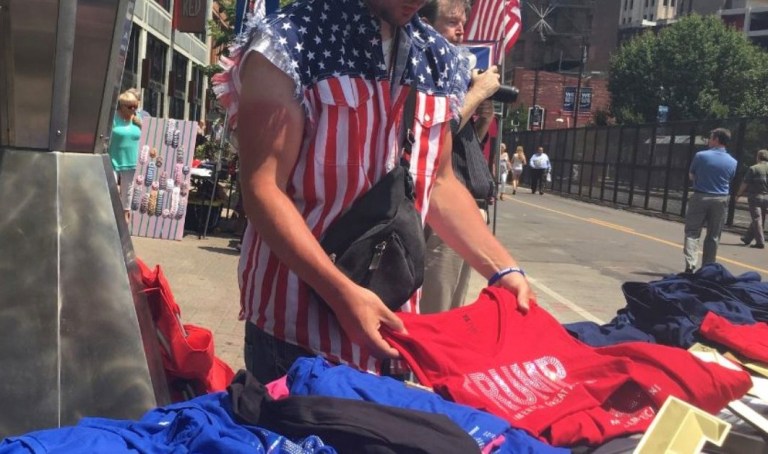
It is, as they say, all over but for the counting. Millions of Americans are going to the polls today for the American election, and tens of millions will spend their evening watching the returns roll in. Some will be overjoyed, some will be crestfallen — but no matter what the outcome is, the majority of Americans will at least be relieved that the campaign is over.
Political campaigns here in the States are lengthy affairs — and even in a normal season after 18 months of stump speeches, debates, rallies, conventions and television ads, most people have had enough. And this campaign season has been … we’ll leave it at unique.
Although the bulk of Americans may be happy to see the 2016 American election season pass into the past tense, at least one group of people will likely be saddened at its departure: swag dealers. The T-shirt, bumper stickers, figures, woman cards, campaign-themed cookware and hats — so many hats — all seasonal specials with a shelf life that will expire tonight when the last polls close and a winner is called. Campaign gear is less than useful once the campaign ends.
And this year, as it turns out, was a particularly good year for swag dealers working the trail. How good? We took a brief survey of the year in selling to the voting masses.
The Hats That Set The Pace
Whether one loves, loathes or is totally indifferent to Donald Trump and his run for the White House this year — the Trump campaign hats are recognizable to everyone. The most common iteration is the red cap with stark white writing, although the white version with black writing made a strong showing as the campaign went down the home stretch.
Though the hat is recognizable, few Americans would pick out the Carson, Calif.-based company that makes the bulk of them, Cali-Fame.
Located about 20 miles south of Los Angeles, Cali-Fame has no political ties to speak of, according to its president, Brian Kennedy. When the Trump campaign came to call, Kennedy said they were just another client looking for a large batch of hats.
“I said to them, ‘We’re not political. We’re here to work,’” Kennedy told the Los Angeles Times from the second floor of his factory, the steady sound of sewing machines in action below him. “And I haven’t gotten any negative comments.”
The 30,000-square-foot warehouse employs about 100 workers, about 80 of whom are Latino (all with verified immigration statuses, according to Kennedy). And the “Making America Great” hat has been big business for the small U.S.-based firm: In the last financial quarter alone, the company snapped up over $1 million in business from the Trump campaign, according to campaign finance records.
On the retail end, the hats have also been big business for the Trump campaign, as both partisans in the movement and hipsters mocking it have turned out to be strong customers for the $25-a-shot hats.
Why are the hats such favorites? According to Kennedy, no matter one’s opinion of the campaign, the hat itself is a designed winner.
“The five-panel trucker hat with cord, it’s a classic,” said Kennedy. “Everything comes full circle in the fashion business. It’s straight from Middle America to New York and Los Angeles.”
The New Classics
American Election 2016 has not just been a boon for bigg(ish) shops like Cali-Fame — it has also been a boon to some small merchants. Extremely small merchants — often one-man- (or woman) shows like Nakai Ogletree’s — a man who has gone to over 200 rallies throughout the nation this election season and collected thousands of dollars a day, in some cases selling the commemorative kitsch of this election.
“The best part is that I’ve been so busy I haven’t even had time to spend it,” the 41-year-old Cleveland native told reporters.
Most of those rallies have been Trump rallies, he said, and most of the swag has been Donald Trump’s. It isn’t so much a matter of rally size as much as it is who is willing to spend. Democrats this year — even when gathering en masse — weren’t dropping major change. Republicans this year, on the other hand, didn’t just go to the rallies — they made sure they picked up souvenirs.
Lots of them, according to Ogletree.
“At one Trump rally, I make probably $3,000, $4,000,” Ogletree said. “I’ve been to many Hillary rallies and made, like, $60. The whole rally. I’m talking with, like, 3,000 people.”
Liberty Sibon George, another vendor, further noted that Trump had a lot more rallies to sell at.
And this year, because the market has been flooded with merchandise and opportunities to sell that have been unique, the sellers themselves, an army of individuals designing their own swag and having it created in small shops, have formed something like an informal community of sellers.
“It’s an underground network,” said George. “A network of a business that’s not really supposed to be there; none of it’s official. But it’s gotta be there. If it’s not there, they come looking for it. The candidates love us being there.”
And for the money, vendors like George and Ogletree have loved being there — although even they are ready for it all to be over, to go home, to count their money and to perhaps buy themselves something instead of selling.
But they are proud of what they contributed to the landscape this year.
“All of us eat well, we make good money,” George noted. “We’re the last pure element of the American dream.”